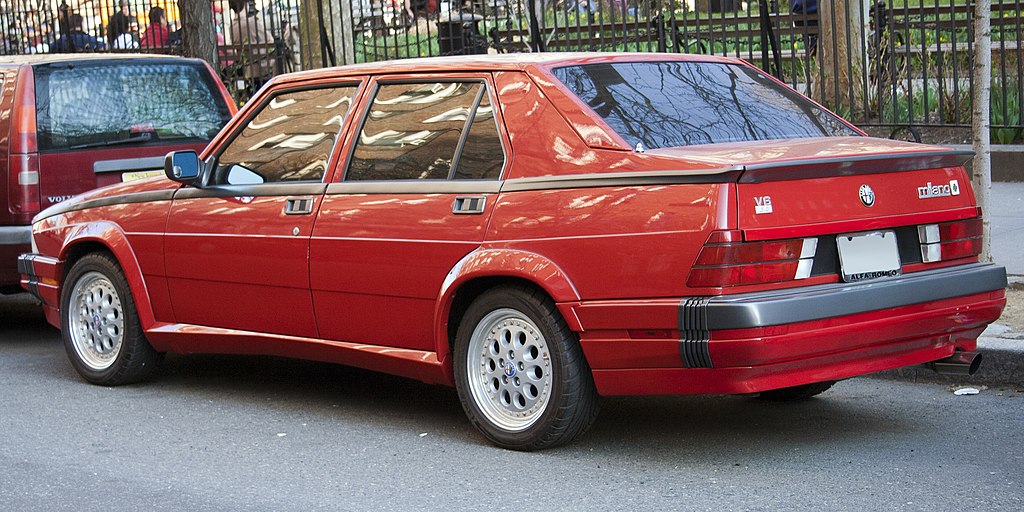1983-1994 33
The Alfa Romeo 33 (Type 905 and 907) is a small family car produced by the Italian automaker Alfa Romeo between 1983 and 1995. From a mechanical standpoint it was essentially an evolution of its predecessor, the Alfasud, whose floorpan, chassis and drivetrain were carried over—albeit with modifications to the suspension and braking system. The Nissan-based Alfa Romeo Arna was launched shortly after, offering a similarly sized but lower priced car.
The 33 has a unique place in the Alfa Romeo history, as nearly 1 million of these cars were produced. During its 11-year lifespan the 33 saw a light facelift in 1986 and a significant restyle in 1989. The 33 was discontinued in 1994 and replaced by the Alfa Romeo 145 and 146, which used the same boxer engines but built around an entirely new platform based on the Fiat Tipo.
1984-1987 Arna
The Alfa Romeo Arna (Type 920) is a small family car produced by the Italian manufacturer Alfa Romeo Nissan Autoveicoli S.p.A. between 1983 and 1987. The company was founded on 9 October 1980, as a 50:50 joint venture between the Italian Alfa Romeo S.p.A. and the Japanese Nissan Motor Company.
The Arna was initially sold as a three door L and a five door SL, and was fitted with the Alfasud 1.2 boxer engine (63 PS). In 1984, a three door TI version, with an 86 PS (63 kW; 85 hp) 1.3 litre boxer four engine, was introduced, which was capable of reaching 170 km/h (110 mph) top speed. In November 1984 (model year 1985) came a more powerful 1.2 engine in the same trim configurations with 68 PS (50 kW; 67 hp), while there were no external differences there were light alterations to the interior.
Later, there were also some TI trim cars built with 1.5 litre engines, sold also as the Nissan Cherry Europe GTI. The more powerful 1.5 TI/Cherry GTI had a top speed of 175 km/h (109 mph). The TI version was discontinued halfway through 1986.
1984-1987 90
The Alfa Romeo 90 (Type 162A) is an executive car produced by Italian car manufacturer Alfa Romeo between 1984 and 1987.
Designed by Bertone and introduced at the 1984 Turin Motor Show, the 90 was pitched between the Alfa Romeo Giulietta (nuova) and the Alfa Romeo Alfa 6, both of which were soon discontinued after the 90's launch. The car used the Alfetta chassis (including its rear mounted transaxle) and took its engines from the larger Alfa 6. The bodywork was similar to both, albeit modernised. One notable feature of the 90's design was small chin spoiler which extended above a certain speed to aid engine cooling. Its angular lines with integrated bumpers gave the car a neat look consistent with the period, however the aerodynamics suffered with a drag coefficient of Cd=0.37.
The 90 was well equipped, including electric front windows and electrically adjustable seats as standard. The luxurious Gold Cloverleaf (Quadrifoglio Oro) model had electric rear windows, a trip computer, power steering, central locking, metallic paint and a digital instrument panel as standard.
The 90 was revamped in 1986 with many minor changes throughout, the most obvious exterior change being a new grille with smaller horizontal slants. Total 56,428 cars were sold within 4 years.
The 90 was made only as sedan but in 1985 Carrozzeria Marazzi developed an Alfa 90 Station Wagon prototype, only two cars were made.
1985-1992 75
The Alfa Romeo 75 (Tipo 161, 162B), sold in North America as the Milano, is a compact executive car produced by the Italian automaker Alfa Romeo between 1985 and 1992. The Alfa 75 was commercially quite successful: in only three years, 236,907 cars were produced, and by the end of production in 1992, around 386,767 had been built.
The Alfa Romeo 75 was the last model released before Alfa Romeo was acquired by Fiat. (The Alfa Romeo 164 was the last model developed independently.)
The 75 was introduced in May 1985 to replace the Giulietta (with which it shared many components), and was named to celebrate Alfa's 75th year of production. The body, designed by head of Centro Stile Alfa Romeo Ermanno Cressoni, was styled in a striking wedge shape, tapering at the front with square headlights and a matching grille (similar features were applied to the Cressoni-designed 33).
At the 1986 Turin Auto Salon, a prototype 75 estate was to be seen, an attractive forerunner of the later 156 Sportwagon. This version was, however, never listed for sale, being cancelled after Fiat took control of Alfa Romeo. The car, dubbed the 75 Turbo Wagon, was made by Italian coachbuilder Rayton Fissore using a 75 Turbo as the basis.Two estate versions were to be found at the later 1987 Geneva Motor Show; one was this Turbo Wagon and the other was a 2.0-litre version named the Sportwagon.
1987-1998 164
The Alfa Romeo 164 (codenamed Type 164) is a four-door executive saloon that was manufactured by the Italian automaker Alfa Romeo from 1987 to 1998 and designed by Pininfarina. Its predecessors of the 164 was the Alfetta, and its Alfa 6 derivative. It was superseded by the 166 in 1998, after a total of 273,857 domestic and export 164 units.
1989-1993 SZ/RZ
The Alfa Romeo SZ (Sprint Zagato) or ES-30 (Experimental Sportscar 3.0 litre) is a high-performance limited-production sports car/road-concept car built between 1989 and 1991 with partnership via Centro Stile Zagato, Centro Stile Alfa Romeo and Centro Stile Fiat. It was unveiled as ES-30 in 1989 Geneva Motor Show as a prototype by Zagato, although the car was mainly built by them - not designed mechanically.



.jpg/800px-1984_Alfa_Romeo_33_hatchback_(16330649021).jpg)

.jpg/800px-1985_Alfa_Romeo_33_GCL_hatchback_(18862978040).jpg)


.jpg/800px-Alfa_Romeo_90_Quadrifoglio_Oro_(8996840712).jpg)
.jpg/800px-Alfa_Romeo_MIlano_(America).jpg)











.jfif)


No comments:
Post a Comment